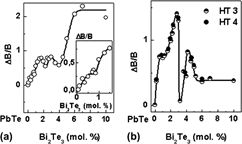Article contents
Evidence for self-organization processes in PbTe-Bi2Te3 semiconductor solid solutions
Published online by Cambridge University Press: 29 June 2011
Abstract

The dependences of unit cell parameter, x-ray diffraction line width B, and microhardness H on the composition of PbTe-Bi2Te3 (0–10 mol% Bi2Te3) semiconductor alloys, subjected to different types of heat treatment, were obtained. In the concentration ranges ∼0.5–1.5 and 3–4 mol% Bi2Te3 within the homogeneity region of PbTe (0–6 mol% Bi2Te3), anomalous constancy or decrease in B and H was observed. A long room temperature aging leads to a more distinct manifestation of these effects. It is suggested that the observed peculiarities in the concentration dependences of the properties are connected with percolation effects and self-organization processes in the solid solution.
- Type
- Articles
- Information
- Copyright
- Copyright © Materials Research Society 2011
References
REFERENCES
- 8
- Cited by


